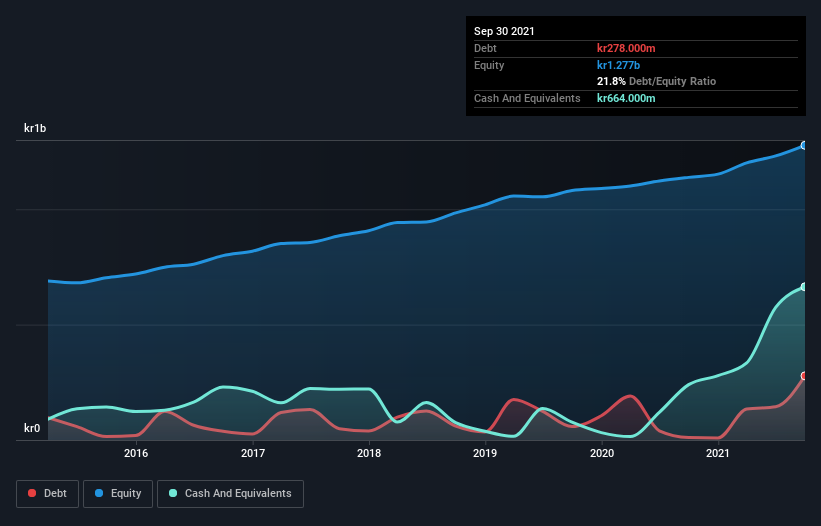Some say volatility, rather than debt, is the best way to think about risk as an investor, but Warren Buffett famously said that 'Volatility is far from synonymous with risk.' When we think about how risky a company is, we always like to look at its use of debt, since debt overload can lead to ruin. As with many other companies KABE Group AB (publ.) (STO:KABE B) makes use of debt. But the real question is whether this debt is making the company risky.
Why Does Debt Bring Risk?
Debt and other liabilities become risky for a business when it cannot easily fulfill those obligations, either with free cash flow or by raising capital at an attractive price. If things get really bad, the lenders can take control of the business. However, a more common (but still painful) scenario is that it has to raise new equity capital at a low price, thus permanently diluting shareholders. Having said that, the most common situation is where a company manages its debt reasonably well - and to its own advantage. When we examine debt levels, we first consider both cash and debt levels, together.
See our latest analysis for KABE Group AB (publ.)
What Is KABE Group AB (publ.)'s Net Debt?
As you can see below, at the end of September 2021, KABE Group AB (publ.) had kr278.0m of debt, up from kr11.0m a year ago. Click the image for more detail. However, its balance sheet shows it holds kr664.0m in cash, so it actually has kr386.0m net cash.

A Look At KABE Group AB (publ.)'s Liabilities
We can see from the most recent balance sheet that KABE Group AB (publ.) had liabilities of kr663.0m falling due within a year, and liabilities of kr207.0m due beyond that. Offsetting this, it had kr664.0m in cash and kr390.0m in receivables that were due within 12 months. So it can boast kr184.0m more liquid assets than total liabilities.
This short term liquidity is a sign that KABE Group AB (publ.) could probably pay off its debt with ease, as its balance sheet is far from stretched. Simply put, the fact that KABE Group AB (publ.) has more cash than debt is arguably a good indication that it can manage its debt safely.
Even more impressive was the fact that KABE Group AB (publ.) grew its EBIT by 203% over twelve months. If maintained that growth will make the debt even more manageable in the years ahead. When analysing debt levels, the balance sheet is the obvious place to start. But it is KABE Group AB (publ.)'s earnings that will influence how the balance sheet holds up in the future. So when considering debt, it's definitely worth looking at the earnings trend. Click here for an interactive snapshot.
Finally, while the tax-man may adore accounting profits, lenders only accept cold hard cash. While KABE Group AB (publ.) has net cash on its balance sheet, it's still worth taking a look at its ability to convert earnings before interest and tax (EBIT) to free cash flow, to help us understand how quickly it is building (or eroding) that cash balance. Over the last three years, KABE Group AB (publ.) actually produced more free cash flow than EBIT. There's nothing better than incoming cash when it comes to staying in your lenders' good graces.
Summing up
While it is always sensible to investigate a company's debt, in this case KABE Group AB (publ.) has kr386.0m in net cash and a decent-looking balance sheet. And it impressed us with free cash flow of kr426m, being 132% of its EBIT. So we don't think KABE Group AB (publ.)'s use of debt is risky. The balance sheet is clearly the area to focus on when you are analysing debt. However, not all investment risk resides within the balance sheet - far from it. For instance, we've identified 3 warning signs for KABE Group AB (publ.) (1 is a bit unpleasant) you should be aware of.
If you're interested in investing in businesses that can grow profits without the burden of debt, then check out this free list of growing businesses that have net cash on the balance sheet.
Valuation is complex, but we're here to simplify it.
Discover if KABE Group AB (publ.) might be undervalued or overvalued with our detailed analysis, featuring fair value estimates, potential risks, dividends, insider trades, and its financial condition.
Access Free AnalysisHave feedback on this article? Concerned about the content? Get in touch with us directly. Alternatively, email editorial-team (at) simplywallst.com.
This article by Simply Wall St is general in nature. We provide commentary based on historical data and analyst forecasts only using an unbiased methodology and our articles are not intended to be financial advice. It does not constitute a recommendation to buy or sell any stock, and does not take account of your objectives, or your financial situation. We aim to bring you long-term focused analysis driven by fundamental data. Note that our analysis may not factor in the latest price-sensitive company announcements or qualitative material. Simply Wall St has no position in any stocks mentioned.
About OM:KABE B
KABE Group AB (publ.)
Engages in the construction and sale of caravans, motorhomes, and camping accessories in Sweden, the United Kingdom, Germany, Norway, Finland, Denmark, Poland, and internationally.
Excellent balance sheet average dividend payer.
Similar Companies
Market Insights
Community Narratives


Recently Updated Narratives


MINISO's fair value is projected at 26.69 with an anticipated PE ratio shift of 20x


The Quiet Giant That Became AI’s Power Grid


Nova Ljubljanska Banka d.d will expect a 11.2% revenue boost driving future growth
Popular Narratives


The company that turned a verb into a global necessity and basically runs the modern internet, digital ads, smartphones, maps, and AI.


MicroVision will explode future revenue by 380.37% with a vision towards success



